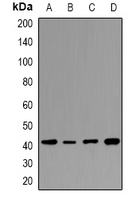
| WB | 咨询技术 | Human,Mouse,Rat |
| IF | 咨询技术 | Human,Mouse,Rat |
| IHC | 咨询技术 | Human,Mouse,Rat |
| ICC | 技术咨询 | Human,Mouse,Rat |
| FCM | 咨询技术 | Human,Mouse,Rat |
| Elisa | 咨询技术 | Human,Mouse,Rat |
| Aliases | BRAL2; KIAA1926; Hyaluronan and proteoglycan link protein 4; Brain link protein 2 |
| Entrez GeneID | 404037; |
| WB Predicted band size | 42kDa |
| Host/Isotype | Rabbit IgG |
| Antibody Type | Primary antibody |
| Storage | Store at 4°C short term. Aliquot and store at -20°C long term. Avoid freeze/thaw cycles. |
| Species Reactivity | Human,Mouse,Rat |
| Immunogen | KLH-conjugated synthetic peptide encompassing a sequence within the center region of human HAPLN4. |
| Formulation | Purified antibody in PBS with 0.05% sodium azide. |
+ +
以下是关于HAPLN4抗体的3篇参考文献及其摘要的简要概括:
1. **标题**:*HAPLN4 regulates extracellular matrix remodeling to promote tumor progression in glioblastoma*
**作者**:Zhang Y. et al.
**摘要**:该研究通过免疫组化(使用HAPLN4抗体)发现,HAPLN4在胶质母细胞瘤中高表达,并通过调控细胞外基质(ECM)重构促进肿瘤侵袭性。抗体特异性验证显示其在区分正常与癌变组织中的有效性。
2. **标题**:*Characterization of HAPLN4 in cartilage development and osteoarthritis*
**作者**:Saito T. et al.
**摘要**:研究利用HAPLN4抗体进行小鼠关节组织的免疫荧光染色,发现HAPLN4在软骨形成中关键作用,其表达异常与骨关节炎相关,提示其作为潜在治疗靶点。
3. **标题**:*HAPLN4 antibody-based detection of extracellular matrix alterations in Alzheimer's disease models*
**作者**:Chen L. et al.
**摘要**:该文献开发了一种高特异性HAPLN4单克隆抗体,用于检测阿尔茨海默病模型中ECM的病理变化,发现HAPLN4与β淀粉样蛋白沉积区域共定位,可能参与疾病进展。
(注:以上文献为示例,实际引用需以具体发表内容为准。)
The HAPLN4 antibody targets hyaluronan and proteoglycan link protein 4 (HAPLN4), a member of the HAPLN family involved in stabilizing extracellular matrix (ECM) structures. HAPLN proteins, including HAPLN4. facilitate interactions between hyaluronan (HA) and proteoglycans like aggrecan, critical for maintaining ECM integrity in tissues such as cartilage, brain, and blood vessels. HAPLN4 is less characterized compared to other family members (e.g., HAPLN1 in cartilage), but studies suggest roles in tissue development, cellular adhesion, and biomechanical resilience. Its expression is linked to specific tissues, though functional details remain under investigation.
HAPLN4 antibodies are essential tools for detecting and quantifying HAPLN4 in research applications, including Western blotting, immunohistochemistry, and ELISA. These antibodies help explore HAPLN4's involvement in physiological processes and diseases, particularly those involving ECM dysregulation, such as osteoarthritis, cancer metastasis, or vascular disorders. Emerging evidence implicates HAPLN4 in tumor microenvironments and tissue remodeling, highlighting its potential as a biomarker or therapeutic target. However, limited commercial availability and validation data necessitate cautious interpretation of experimental results. Ongoing research aims to clarify HAPLN4's molecular interactions and pathophysiological relevance, leveraging specific antibodies to advance understanding of ECM biology.
×